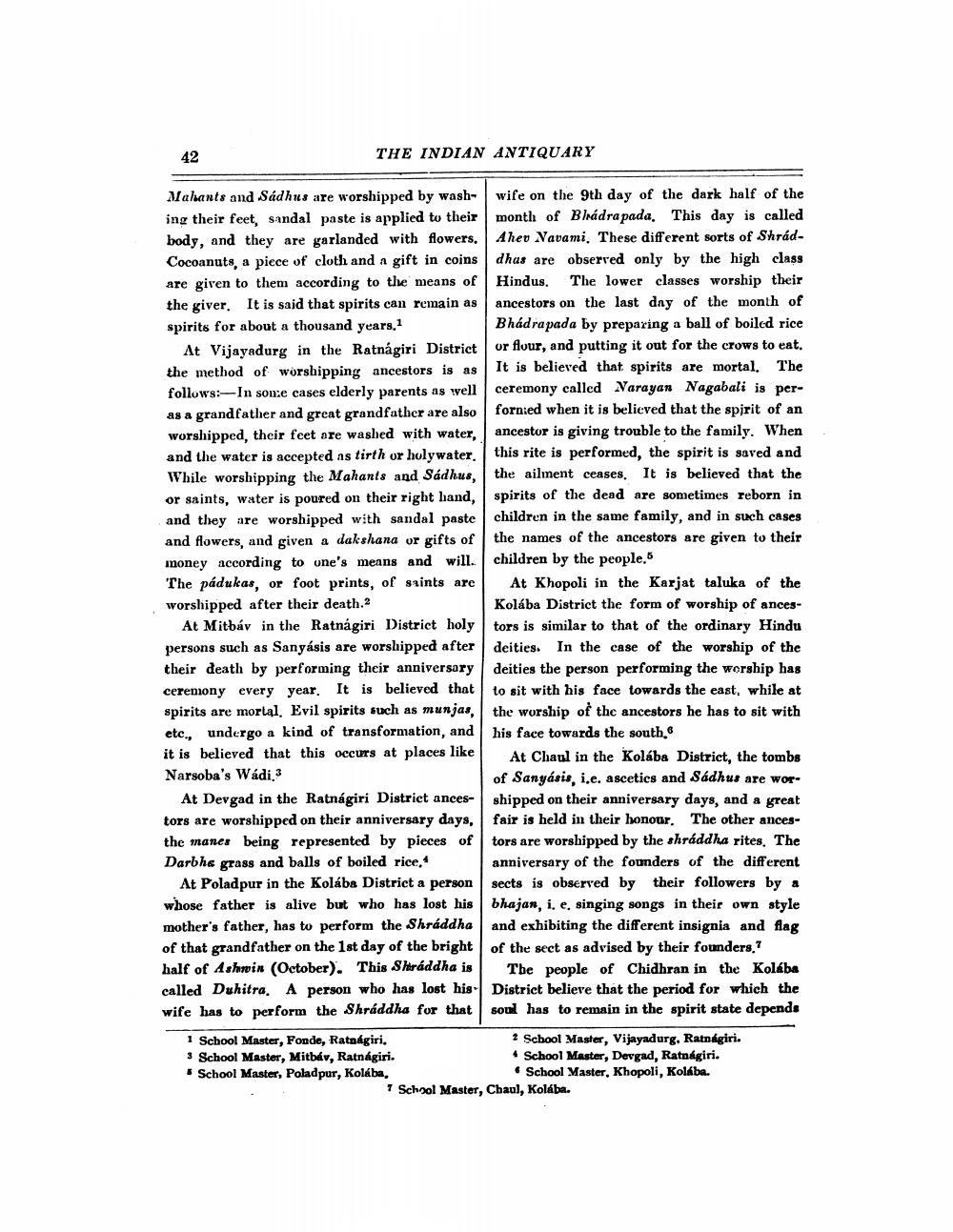________________
42
THE INDIAN ANTIQUARY
Mahants and Sádhus are worshipped by washing their feet, sandal paste is applied to their body, and they are garlanded with flowers. Cocoanuts, a piece of cloth and a gift in coins are given to them according to the means of the giver. It is said that spirits can remain as spirits for about a thousand years,1
At Vijayadurg in the Ratnagiri District the method of worshipping ancestors is as follows:-In some cases elderly parents as well as a grandfather and great grandfather are also worshipped, their feet are washed with water, and the water is accepted as tirth or holywater. While worshipping the Mahants and Sádhus, or saints, water is poured on their right hand, and they are worshipped with sandal paste and flowers, and given a dakshana or gifts of money according to one's means and will. The pádukas, or foot prints, of saints are worshipped after their death.2
At Mitbáv in the Ratnagiri District holy persons such as Sanyásis are worshipped after their death by performing their anniversary ceremony every year. It is believed that spirits are mortal. Evil spirits such as munjas, etc., undergo a kind of transformation, and it is believed that this occurs at places like Narsoba's Wádi,3
At Devgad in the Ratnagiri District ancestors are worshipped on their anniversary days, the manes being represented by pieces of Darbhe grass and balls of boiled rice,
At Poladpur in the Kolába District a person whose father is alive but who has lost his mother's father, has to perform the Shraddha of that grandfather on the 1st day of the bright half of Ashwin (October). This Shraddha is called Duhitra. A person who has lost his wife has to perform the Shráddha for that
1 School Master, Fonde, Ratnagiri, 3 School Master, Mitbáv, Ratnagiri. School Master, Poladpur, Kolába,
wife on the 9th day of the dark half of the month of Bhadrapada. This day is called Ahev Navami. These different sorts of Shráddhus are observed only by the high class Hindus. The lower classes worship their ancestors on the last day of the month of Bhadrapada by preparing a ball of boiled rice or flour, and putting it out for the crows to eat. It is believed that spirits are mortal. The ceremony called Narayan Nagabali is perforned when it is believed that the spirit of an ancestor is giving trouble to the family. When this rite is performed, the spirit is saved and the ailment ceases. It is believed that the spirits of the dead are sometimes reborn in children in the same family, and in such cases the names of the ancestors are given to their children by the people.5
At Khopoli in the Karjat taluka of the Kolába District the form of worship of ancestors is similar to that of the ordinary Hindu deities. In the case of the worship of the deities the person performing the worship has to sit with his face towards the east, while at the worship of the ancestors he has to sit with his face towards the south.
At Chaul in the Kolába District, the tombs of Sanyásis, i.e. ascetics and Sádhus are worshipped on their anniversary days, and a great fair is held in their honour. The other ancestors are worshipped by the shráddha rites. The anniversary of the founders of the different sects is observed by their followers by a bhajan, i, e, singing songs in their own style and exhibiting the different insignia and flag of the sect as advised by their founders,?
The people of Chidhran in the Kolába District believe that the period for which the soul has to remain in the spirit state depends
2 School Master, Vijayadurg, Ratnagiri.
4 School Master, Devgad, Ratnagiri.
• School Master, Khopoli, Kolába.
7 School Master, Chaul, Kolába.




